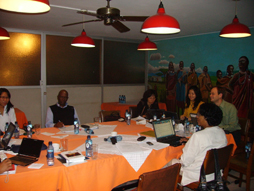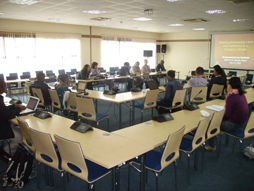This project seeks to improve laws governing biodiversity so that they better adapt to the changing climate. ELI has planned a broad, integrated set of activities over the next three years that will involve:
- analyzing current legal frameworks and existing literature;
- identifying ways to strengthen legal, regulatory, and institutional frameworks governing biodiversity to more effectively adapt to the effects of climate change;
- developing and disseminating guidance materials for decision makers and legal drafters;
- raising awareness of the need to review laws governing biodiversity; and
- building capacity of key institutions for strengthening legal frameworks.
With the expert guidance of the Advisory Committee, we are producing a Strategic Options Paper for decision makers and a more detailed comprehensive Resource Manual for resource managers, resource advocates, and legislative drafters. The Strategic Options Paper explains why it is necessary to design legal and institutional frameworks that govern biodiversity in light of climate change and offer specific options for strengthening biodiversity laws, policies, and institutions. The Resource Manual provides more detailed technical and legal guidance on how to review, revise, draft, and use such legal tools. The Strategic Options Paper is essential in raising awareness of high-level decision makers and stakeholders broadly; while the Resource Manual sets forth specific technical options for resource managers. Both the Strategic Options Paper and Resource Manual focus on adaptation of biodiversity management, with a strong component dedicated to livelihoods that depend on biodiversity.
In addition, we are reaching out to major organizations and governmental bodies involved with biodiversity management decisions in order to build a stronger network of experts versed in the principles of adaptive biodiversity management. Through dialogues and capacity-building exercises, we hope to raise global awareness about the critical role of law in biodiversity adaptation efforts.
Activities in 2010

In May of 2010, ELI staff and the seven members of the Advisory Committee held a Second Advisors Meeting to discuss drafts of the Resource Manual and Strategic Options Paper and next steps for the project. The meeting was held in conjunction with Meeting 14 of the Subsidiary Body on Science, Technical, and Technological Advice (SBSTTA) of the Convention on Biological Diversity, held at UNEP facilities in Nairobi, Kenya. In sessions held May 12 and 13, the Advisory Committee (1) developed recommendations on building a community of practice around legal reforms for adaptive biodiversity governance, (2) identified indicators and discussed opportunity for holding national dialogues in several focal countries to initiate legislative and administrative actions on climate change and biodiversity, and (3) discussed revising, publishing, and disseminating the project’s primary materials, the Resource Manual and Strategic Options Paper.
On May 14, ELI staff and members of the Advisory Committee hosted a Side Event at the SBSTTA Meeting at UNEP. We engaged party-delegates and civil society experts from around the world to discuss biodiversity adaptation and identify ways to make our materials stronger and more relevant to the needs of governments, NGOs, communities, and businesses. We distributed USB drives containing our work for participants to take home to their countries and share with colleagues and practitioners. Members of the Advisory Committee discussed how their work on the project has already had an impact in developing new legislation and reviewing existing laws to determine whether they will be effective to protect biodiversity from climate change impacts.
After extensive revisions to take into account comments received from the Advisory Committee and from participants at the SBSTTA Meeting, we finalized the Resource Manual and Strategic Options Paper in October 2010. We held a Side Event at the tenth meeting of the Conference of the Parties to the Convention on Biological Diversity. We distributed over 150 copies of the Resource Manual and Strategic Options Paper and held an engaging discussion with Side Event participants about these tools and issues.
Activities in 2009

In May 2009, ELI staff and members of the Advisory Committee convened the first formal Advisory Committee meeting at the Philip Merrill Center on the Chesapeake Bay. Over three days, the group outlined the major issues to address at the intersection of biodiversity adaptation and climate change and outlined the Resource Manual the group would draft.
On June 3, 2009, ELI convened What Does Adaptation to Climate Change Mean for Biodiversity Law? An International Roundtable Discussion. This panel of lawyers from six developing countries explored the implications of climate change adaptation for laws governing biological resources and examined the capacity of existing national biodiversity laws to adapt to climate change. They also explored the expanding role of international and civil society institutions, discussed governance capacities and resource constraints that limit the efficacy of legislative mandates, and explored innovative options to improve upon existing laws through adaptive management frameworks. Download audio recordings of the roundtable as well as the presentations.
For the remainder of 2009, ELI staff and consultants drafted the Resource Manual and Strategic Options Paper and received a round of comments from the Advisory Committee in early 2010.